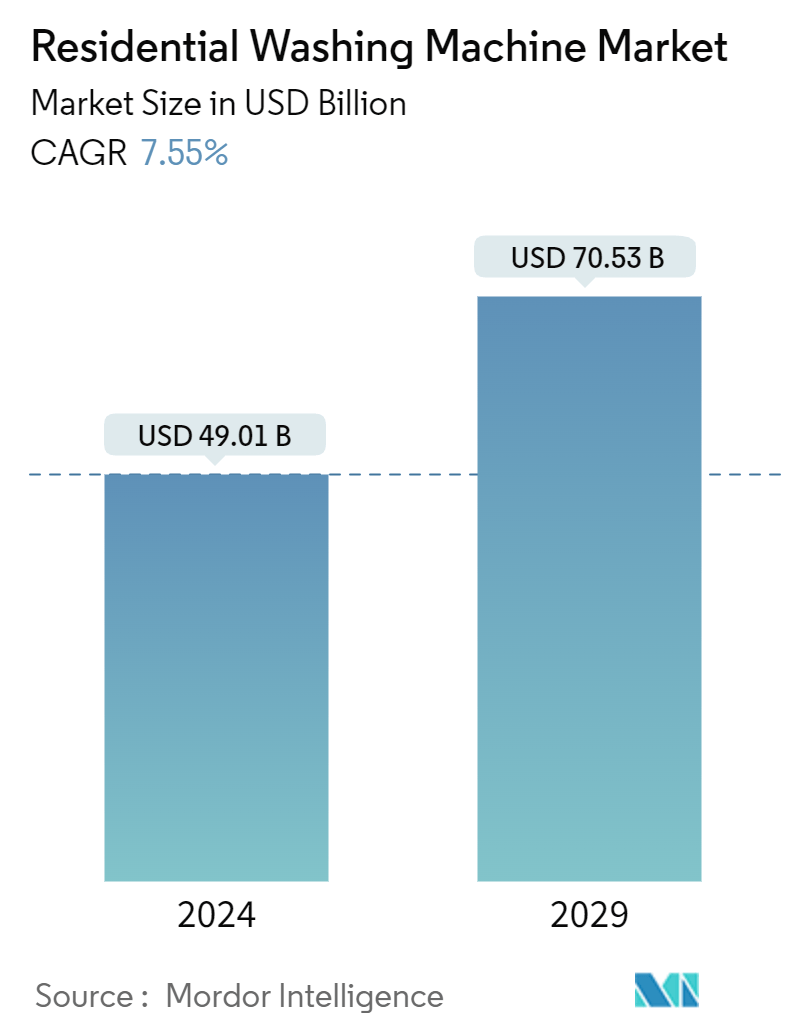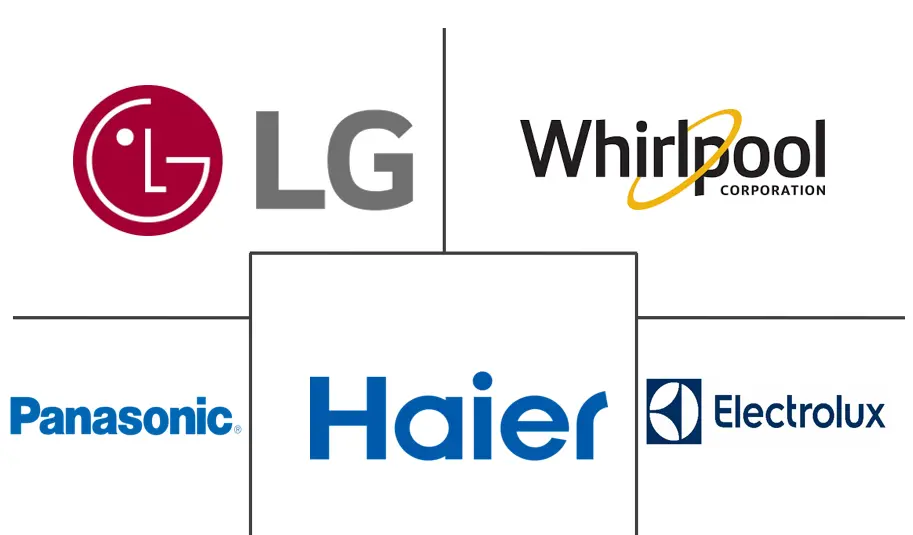Market Size of Residential Washing Machine Industry

| Study Period | 2020-2029 |
| Base Year For Estimation | 2023 |
| Market Size (2024) | USD 49.01 Billion |
| Market Size (2029) | USD 70.53 Billion |
| CAGR (2024 - 2029) | 7.55 % |
| Market Concentration | Low |
Major Players
*Disclaimer: Major Players sorted in no particular order |
Residential Washing Machine Market Analysis
The Residential Washing Machine Market size is estimated at USD 49.01 billion in 2024, and is expected to reach USD 70.53 billion by 2029, growing at a CAGR of 7.55% during the forecast period (2024-2029).
The residential washing machine market encompasses a wide range of products designed for home use, including top-load and front-load washers and washer-dryer combinations. This market is driven by increasing disposable income, urbanization, and changing lifestyles, leading to higher demand for convenient and efficient laundry solutions.
There has been a growing trend toward energy-efficient and water-saving washing machines as consumers become more environmentally conscious. Manufacturers also focus on developing smart washing machines that offer features such as remote monitoring and control via smartphone apps, further enhancing user convenience.
The residential washing machine market is competitive, led by several significant market players vying for market share. Innovation in technology and design and competitive pricing strategies drive competition in this market. Additionally, after-sales service and brand reputation significantly influence consumer purchasing decisions.
Residential Washing Machine Industry Segmentation
A residential washing machine is an appliance used for washing laundry in homes and other residential units. They provide domestic units with an easy and convenient way of washing laundry. Rising innovations are making these machines automatic and energy-efficient for households to use. The residential washing machine market is segmented by type, technology, distribution channel, and geography. By type, the market is segmented into front load and top load. By technology, the market is segmented into fully automatic and semi-automatic. By distribution channel, the market is segmented into multi-brand stores, exclusive stores, online, and other distribution channels (local dealers). By geography, the market is segmented into North America, Europe, Asia-Pacific, Latin America, the Middle East and Africa, and the Rest of the world. The report also covers the market sizes and forecasts for the residential washing machine market in value (USD) for all the above segments.
| By Type | |
| Front Load | |
| Top Load |
| By Technology | |
| Fully-automatic | |
| Semi-automatic |
| By Distribution Channel | |
| Multibrand Stores | |
| Exclusive Stores | |
| Online | |
| Other Distribution Channels |
| North America | |
| United States | |
| Canada | |
| Mexico | |
| Rest of North America |
| Europe | |
| United Kingdom | |
| Germany | |
| France | |
| Russia | |
| Italy | |
| Spain | |
| Rest of Europe |
| Asia-Pacific | |
| India | |
| China | |
| Japan | |
| Australia | |
| Rest of Asia-Pacific |
| South America | |
| Brazil | |
| Argentina | |
| Rest of South America |
| Middle East and Africa | |
| United Arab Emirates | |
| South Africa | |
| Rest of Middle East and Africa |
Residential Washing Machine Market Size Summary
The residential washing machine market is poised for significant growth, driven by factors such as increasing disposable incomes, urbanization, and evolving consumer lifestyles. This market includes a variety of products designed for home use, such as top-load and front-load washers, as well as washer-dryer combinations. The demand for energy-efficient and water-saving machines is on the rise, reflecting a growing consumer preference for environmentally friendly options. Additionally, the integration of smart technology, allowing for features like remote monitoring and control via smartphone apps, is enhancing user convenience and driving market expansion. The competitive landscape is characterized by numerous key players focusing on technological innovation, design advancements, and competitive pricing strategies to capture market share. After-sales service and brand reputation also play crucial roles in influencing consumer purchasing decisions.
The Asia-Pacific region stands out as a dominant market for residential washing machines, fueled by rapid urbanization, rising disposable incomes, and shifting lifestyles. Countries such as China, India, Japan, and South Korea are significant contributors to this growth, with a notable shift towards energy-efficient and smart washing machines. The region is also experiencing a surge in online sales, driven by the popularity of e-commerce platforms, which offer consumers a wider range of products and the convenience of home shopping. The market is highly fragmented, with numerous manufacturers leveraging technological advancements and product innovations to differentiate their offerings. Companies like LG Electronics Inc., Whirlpool Corporation, and Electrolux AB are prominent players in this space, actively expanding their product lines and enhancing their market presence through strategic investments and collaborations.
Residential Washing Machine Market Size - Table of Contents
-
1. MARKET DYNAMICS AND INSIGHTS
-
1.1 Market Overview
-
1.2 Market Drivers
-
1.2.1 Increasing Urbanization Raising Sales of Residential Washing Machines
-
1.2.2 Increasing Demand for Convenience
-
-
1.3 Market Restraints
-
1.3.1 Supply Chain Disruptions with Rising Geopolitical Tensions
-
1.3.2 Environmental Concern and High Power Consumption
-
-
1.4 Market Opportunities
-
1.4.1 Increasing Demand for Smart Features in Residential Washing Machines
-
-
1.5 Industry Attractiveness - Porters' Five Forces Analysis
-
1.5.1 Threat of New Entrants
-
1.5.2 Bargaining Power of Buyers
-
1.5.3 Bargaining Power of Suppliers
-
1.5.4 Threat of Substitutes
-
1.5.5 Intensity of Competitive Rivalry
-
-
1.6 Technological Innovations in Residential Washing Machine Market
-
1.7 Impact of COVID-19 on the Market
-
-
2. MARKET SEGMENTATION
-
2.1 By Type
-
2.1.1 Front Load
-
2.1.2 Top Load
-
-
2.2 By Technology
-
2.2.1 Fully-automatic
-
2.2.2 Semi-automatic
-
-
2.3 By Distribution Channel
-
2.3.1 Multibrand Stores
-
2.3.2 Exclusive Stores
-
2.3.3 Online
-
2.3.4 Other Distribution Channels
-
-
2.4 By Geography
-
2.5 North America
-
2.5.1 United States
-
2.5.2 Canada
-
2.5.3 Mexico
-
2.5.4 Rest of North America
-
-
2.6 Europe
-
2.6.1 United Kingdom
-
2.6.2 Germany
-
2.6.3 France
-
2.6.4 Russia
-
2.6.5 Italy
-
2.6.6 Spain
-
2.6.7 Rest of Europe
-
-
2.7 Asia-Pacific
-
2.7.1 India
-
2.7.2 China
-
2.7.3 Japan
-
2.7.4 Australia
-
2.7.5 Rest of Asia-Pacific
-
-
2.8 South America
-
2.8.1 Brazil
-
2.8.2 Argentina
-
2.8.3 Rest of South America
-
-
2.9 Middle East and Africa
-
2.9.1 United Arab Emirates
-
2.9.2 South Africa
-
2.9.3 Rest of Middle East and Africa
-
-
Residential Washing Machine Market Size FAQs
How big is the Residential Washing Machine Market?
The Residential Washing Machine Market size is expected to reach USD 49.01 billion in 2024 and grow at a CAGR of 7.55% to reach USD 70.53 billion by 2029.
What is the current Residential Washing Machine Market size?
In 2024, the Residential Washing Machine Market size is expected to reach USD 49.01 billion.

